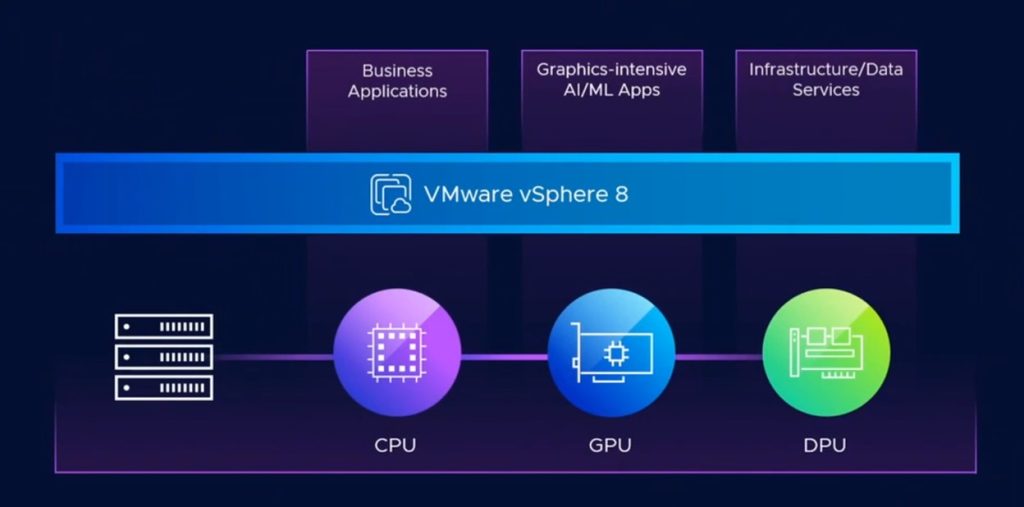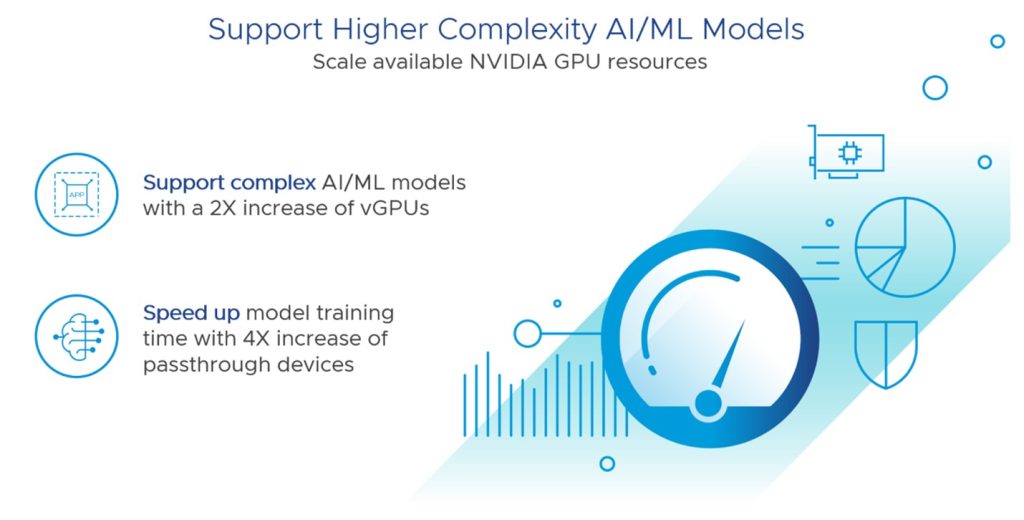We hope our VMware Cloud Service Providers are excited about the upcoming release for vSphere 8, and the great new features and capabilities that are coming with this release. This latest release continues to build on the incredible mission of delivering a highly scalable enterprise workload platform with performance and operational efficiencies that are designed to bring the benefits of cloud to on-premises workloads. VMware Cloud Services Providers can take advantage of these key enhancements in vSphere to continue the rapid expansion and transition of traditional and cloud-native workloads to OpEx models, whether its on-premise solutions using the Flex Core model for our Cloud Builders (rental portfolio) or our asset-light Managed Service Providers (MSP portfolio).
What’s new in vSphere 8
As mentioned in the keynote at VMware Explore, the newest release of vSphere includes important capabilities that will help transform and supercharge workload performance for today’s intensive cloud-native, AI/ML, and large scale workloads. Here is a quick list of new features which Cloud Providers will be interested in taking advantage of in their cloud infrastructure environments to further improve on the value of the platform to their tenants:
- Introduction of vSphere Distributed Services Engine, which unlocks the power of all-new Data Processing Units (DPUs) for hardware accelerated infrastructure and data processing to simplify Infrastructure and workload management, strengthen infrastructure security, and boost infrastructure performance.

Why this is important for Cloud Providers: Modern cloud-native applications (such as those built on VMware Cloud Foundation with Tanzu and with Tanzu for Kubernetes Operations) are consuming more of the server CPU cycles. Similar to GPUs and FPGAs offloading large computational and graphics-intensive workloads, vSphere Distributed Services Engine and the dedicated compute resources delivered through DPUs will allow Cloud Providers to offload services and networking activities to allow traditional server CPU cycles to be dedicated to application workload processing. This feature improves performance of the overall infrastructure, unifies and provides for consistent operations across all apps including lifecycle management across VCF deployments, and finally improves security through embracing the distributed security and zero-trust security models. Read more about the capabilities here and here.
- Improved AI/ML scale for large, complex models through the support of up to 32 devices in Passthrough mode, representing a 2x increase as compared to vSphere 7. Unified management for AI/ML hardware accelerators simplify how VMs consume hardware device resources. Device groups in vSphere 8 make Virtual Machines consuming complementary hardware devices simpler to manage for tasks such as vSphere DRS and vSphere HA. Finally, device virtualization extensions builds on Dynamic DirectPath I/O providing a framework and API for vendors to create hardware-backed virtual devices, which will improve core virtualization services such as vSphere vMotion, suspending and resuming VMs, and taking memory and disk snapshots.

Why this is important for Cloud Providers: Cloud Providers can offer their tenants higher levels of scalability of available GPU resources with support for up to 8vGPUs per VM, a 2x increase compared to vSphere 7. Device groups configured from discovered AI/ML hardware accelerators supported by vSphere 8 ensure that VMs receive the appropriate resources needed for their data modeling requirements. Within VMware Cloud Director, device groups will reflect as being available for use in vGPU policies, which can help Cloud Providers further simplify VM placement to satisfy requirements for hardware resources based on the device group and vGPU policy assigned. And with device virtualization extensions, Cloud Providers will have broader access to more hardware choices that align with virtualization capabilities offered by the VMware architecture.
- Expanded vSphere performance is delivered in vSphere 8 for VMs by aligning vCPU scheduling with the same hyper-threaded physical CPU cores. In addition vSphere 8 leverages improved memory statistics from vSphere Memory Monitoring and Remediation (first offered in vSphere 7. Update 3). These feature updates ensure optimal placement decisions for VMs are made without affecting performance and resource consumption.
Why this is important for Cloud Providers: Cloud Providers are often tasked with running latency sensitive critical workloads for mission-critical solutions, and require high latency sensitivity and hyper-threading management capabilities to deliver the appropriate performance required for these workloads. By leveraging the improved capabilities of vCPU scheduling and DRS enhancements for VMs, both of which are available and passed seamlessly onto VMware Cloud Director managed workloads, Cloud Providers ensure that workloads get the resources they needed so that critical Service Level Agreements (SLAs) are met, while improving hardware resource consumption to improve the ROI of their infrastructure.
- Tanzu Kubernetes Grid 2.0 on vSphere 8 consolidates the prior Tanzu Kubernetes offerings into a single unified Kubernetes runtime from VMware, adding new flexibility and control for cluster creation, TKG cluster availability zones, open-source API alignment, and improved application lifecycle management capabilities.

Why this is important for Cloud Providers: With vSphere 8, Cloud Providers can offer their tenant DevOps teams access to IaaS style services (like provisioning VMs, networking, setting up Tanzu Kubernetes Grid clusters) easily from the new Cloud Consumption Interface service. The Cloud Consumption Interface simplifies infrastructure setup across the vSphere estate through intuitive UIs and developer-friendly APIs, freeing up time that can be spent on real development efforts. 3-cluster TKG Availability Zones improve overall resilience of containerized workloads from infrastructure failures. Finally, simplified cluster creation is delivered through a Cluster API feature called Cluster Class, which users can call to perform lifecycle operations such as create, scale, upgrade, and delete clusters, all from a single place.
- Expanded lifecycle management capabilities of vSphere Lifecycle Manager will automate remediation of ESXi installations across DPUs and host servers, including staging of update payloads in advance of remediation, parallel remediation processing, and standalone host support. vSphere Lifecycle Manager now can manage up to 1000 hosts.

Why this is important for Cloud Providers: Cloud Providers can take advantage of staging to prepare environments with the necessary bits without placing them in maintenance mode, and parallel remediation of multiple hosts can further reduce maintenance mode downtime.
- Updated security and compliance for vSphere 8 include prevention of running untrusted binaries (those not installed via a VIB), authenticating TLS 1.2 connections for services access (removed TLS 1.0 and TLS 1.1 support), giving SSH sessions idle timeouts to prevent unauthorized access, and enforcing usage of TPM 2.0 for hardware security (removed TPM 1.2 support) for accessing secrets.

Why this is important for Cloud Providers: Ensuring VMware platform infrastructure security is up to date with current security best practices and standards prevent unauthorized access and connections is critical in today’s cloud-connected, zero-trust , distributed infrastructure environments. VMware’s focus on security is at the forefront of each vSphere release, to ensure that Cloud Provider environments are optimally secured out of the box when newly deployed and ready for next generation security protocols.
Additional Resources
With the wealth of new features coming to vSphere 8 for Cloud Service Providers, you can join VMware vmLIVE enablement sessions to learn more in the upcoming weeks. Here is a list of past and upcoming sessions, all of which are available and published as part of the vmLIVE schedule on Partner Connect:
vmLIVE – vSphere 8 Series: #1 Introducing the Enterprise Workload Platform (Replay)
vmLIVE – vSphere 8 Series: #2 How it Brings Benefits of the Cloud to On-Premises Workloads (Replay)
vmLIVE – vSphere 8 Series: #3 How it Helps Supercharge Workload Performance (Register)
Oct 4 2022 4:30 PM GMT
vmLIVE – vSphere 8 Series: #4 How it Helps Accelerate Innovation for DevOps (Register)
Oct 10 2022 4:30 PM GMT
Additionally, read more about the vSphere 8 announcement on our blog website, and further information about the features coming to vSphere 8 at VMware Cloud Platform Tech Zone.
